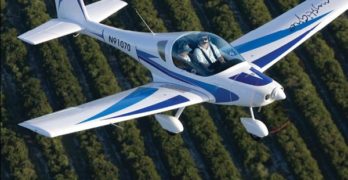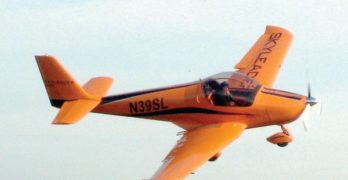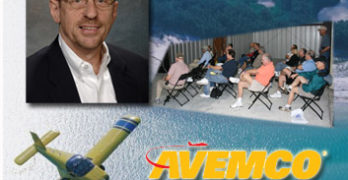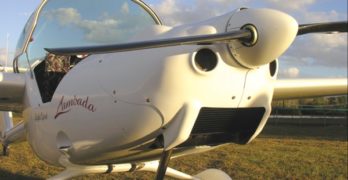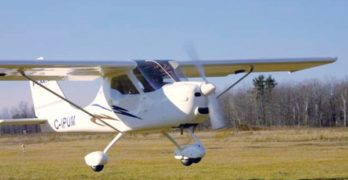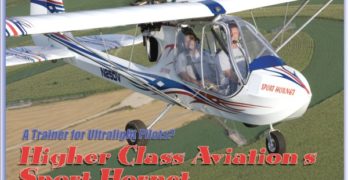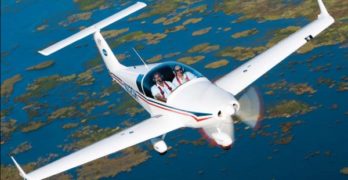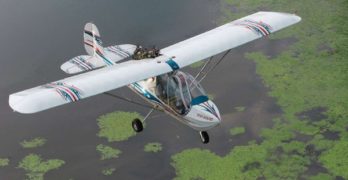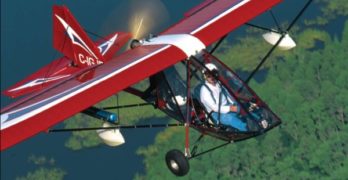But this airplane offers no mystery …
Most pilots will find
nothing mysterious
about the Mystique. In
fact, many readers already
know its manufacturer,
Interplane Aircraft, which
also manufactures the
Skyboy that achieved early
success before light-sport
aircraft (LSA) were given
official status.
Yet to American pilot
eyes, the Mystique is a
new bird on the horizon.
It earned its special lightsport
aircraft (S-LSA)
airworthiness certificate
shortly before the U.S.
Sport Aviation Expo in
mid-January 2007. This is
the second S-LSA approval
for Interplane; Skyboy won
approval in October 2006.
Let’s Meet the Distributor and Manufacturer
Many LSA pilots have come to
know Doug and Betty Hempstead,
the proprietors of several aviation
companies based at the Sanford-Lee
County Regional Airport in North
Carolina. Doug and Betty operate a
flight school, two import enterprises,
and plan to embark on final assembly
of airplanes in the United States.
The Hempsteads import the Allegro,
manufactured in the Czech
Republic by Fantasy Air, under the
Fantasy Air USA name.
Search Results for : CT AND hand control
Not finding exactly what you expected? Try our advanced search option.
Select a manufacturer to go straight to all our content about that manufacturer.
Select an aircraft model to go straight to all our content about that model.
SkyLeader’s Wide-Body LSA
Update Note (2021) — This article published in 2008. The aircraft was then referred to as Skyleader 500. Later this was further upgraded and became the Skyleader 600. Obviously, some information presented below will be dated but much of the flight qualities reporting is still useful. —DJ
Sky Leading KP-5
First, Americans became aware of Kappa. This corporate identity was more easily pronounced than the next company name,
Jihlavan (roughly, “YEE-lah-von”) Airplanes. Now, after new investment and with new global ambitions, the company will be known a “Skyleader Aircraft.” American tongues can relax with this easy reference.
Unchanged are a common owner and the same skilled Jihlavan Airplanes
technicians building the elegant KP-5/Skyleader 500 from the Czech
Republic. It may not be the biggest seller among light sport aircraft (LSA),
but I find it to be one of the finest flying machines in the fleet. Skyleader
plans to standardize the brand around the world and will rename the KP-5
the Skyleader 500.
Avemco Investigates LSA; Continues Insurance
Does FAA control aviation? They regulate it (sometimes well). True control may be in the hands of insurance companies. Just try to operate your airplane, your airport, your aviation business without insurance coverage. Insurance companies help keep airports open and protect our investment in airplanes when we occasionally land a bit hard. *** One company addresses market needs differently. Avemco sells directly to pilots, not through middlemen. This may explain why Avemco is one of the country’s largest airplane insurers. *** Their top man, Avemco President Jim Lauerman, has been out doing his homework on LSA. In our conversation at Sebring 2008, Jim told me about all the LSA leaders he spoke to at the event. Following Sebring he went quite a few extra miles and paid in-person visits to AMD, American Legend, and IndUS Aviation. *** Since Lauerman is personally willing to look carefully at LSA, industry players are likely to heed his advice out of respect for his interest and thoroughness.
Lambada’s Choice
Motor Along Economically
Not all light sport aircraft (LSA) are made alike.
You probably knew that already, but consider
the Lambada. This sleek composite 2-seat
shoulder wing is part airplane, part glider and it has
the interchangeable wing tips to prove it.
For a soaring enthusiast like myself, flying the
Lambada gratified a desire I’ve had for years, since I
first saw the Urban Air design at a German airshow. On
January 9, 2008, I went aloft in a Lambada with Josef
Bostik – a former U.S. National Champion hang glider
pilot turned airline captain – at Wallaby Ranch, an
iconic hang glider park in Central Florida where hang
gliders are towed aloft behind specially built ultralights.
The particular Lambada I flew bore N-number
N109UA. Bostik indicated that 108 other Lambada
aircraft are flying around the world, though the
one I flew is the first ’08 model to pass ASTM standard
certification.
Flying the Puma
One of Canada’s best-kept secrets can be found hidden
away in a northeastern Ontario town called Hawkesbury. That
secret is the PUMA – a little plane being imported into Canada by
Humberto Dramisino of Otreb Technologies.
When you look into the history of ultralight and light sport aviation,
it’s interesting to note that the successful manufacturers are the ones
that introduce a design and then adjust it as times goes by to better fit
the ever-changing aviation marketplace.
This is what has lead to the success of the PUMA. Designed in Italy
by Antonio Bortolanza, the aircraft has undergone a number of design
transitions since it was first introduced in ’85. Dramisino has been
involved with the manufacture of the PUMA from a very early age. He
first started working in the factory when he was only 15 years of age,
“working just for the pleasure of working on airplanes,” he says.
NH:Higher Class Aviation’s Sport Hornet
At the close of business on January 31,
2008, 2-seat ultralight trainers and overweight
single-seater “ultralights” – as
readers of this publication understand these aircraft
– will cease to exist. More correctly, they
must have been converted to Experimental-Light
Sport Aircraft (ELSA) if their owners want to continue
flying them; otherwise these pilots’ options
are sharply limited.
But as Part 103-compliant ultralights continue
and if ultralight trainers go away, how will new
ultralight pilots be trained for flight in these
lightest of aircraft?
Happily, the subject of this month’s flight
review answers that question. Arguably the first
fixed-wing ultralight to make the jump – not to
ELSA conversion status but to full, Special-LSA
(SLSA) approval – is Higher Class Aviation’s
Sport Hornet.
Gaining Higher Class
We first saw the Hornet when Jim Millett
brought this new design to Sun ‘n Fun ’94 (the
event’s 20th anniversary). It was a bold move into
a market looking well established.
CubCrafters All-New Sport Cub
Vintage Looks Mated With Modern Materials
Take 25 years of experience
with rebuilding Piper Cubs,
add a new FAA regulation
allowing more flexibility in designing
and producing aircraft, spice the
mixture with many design changes,
and you get CubCrafters’ Sport Cub.
The Yakima, Washington-based company
has created an airplane that retains
the vintage look of a J-3 Cub
but embraces 21st century materials
and technology.
On a warm evening during
the Sun ‘n Fun Fly-In
at Lakeland, Florida, I
flew with CubCrafters’
pilot Clay Hammond. He
identified company President
Jim Richmond as the primary
motivator behind the Sport Cub.
Richmond has been rebuilding Cubs
for 25 years, during which time he
conceived many changes he wanted
to try. Taking into consideration his
height-he’s 6 feet 4 inches tall-he
wanted to make all the improvements
he’d envisioned for the venerable
Cub, and he wanted the airplane
to fit him.
A Thoroughly Modern Cub
CubCrafters took on the redesign
of the 50-year-old airplane using
modern materials and engineering
software not available to Piper engineers
when the J-3 was created.
Canadian-Designed Czech-Built Skylark
A Doubly International LSA
SportsPlanes.com imports several
light-sport aircraft (LSA)
that have found ready buyers.
After researching through
several designs, SportsPlanes’ owner
Josh Foss originally settled on the
Comco Ikarus C42 and Breezer and
the U.S.-built American Flyer for its
fleet. Most recently, the company
added the Czech-built Dova Skylark
to its offerings.
However, the real story of this company
is not Josh Foss’ care in the selection
of what airplanes to sell. What
may be more important to the marketplace
is the network his company
has built to bring service and support
to SportsPlanes.com’s customers.
Currently, 15 SportsPlanes centers are
operating, with the goal to establish
25 centers nationwide.
Investigating the Skylark
My opportunity to fly the Skylark
came while attending the U.S. Sport
Aviation Expo in Sebring, Florida, in
January. I flew with Darrell Hamilton,
the SportsPlanes representative
for Florida.
Darrell retired from Northwest
Airlines four years ago. He most recently
crewed the fly-by-wire Airbus
A320, which needs only small control
movements.
The Sport Hornet
Is It the First Ultralight SLSA?
Among fixed-wing airplanes, the Sport Hornet from Higher Class Aviation
may be the first ultralight-type airplane to achieve special light-sport
aircraft (S-LSA) status. Several weight-shift trikes and a few powered
parachutes also have made the jump, making declarations of meeting the
ASTM industry consensus standards.
As company owner Robert Gaither and his team made the Hornet ready for the
LSA market, the airplane was put through a series of changes resulting in the
name Sport Hornet.
From Hornet to Super Hornet to Sport Hornet
Jim Millett, of U.S. Light Aircraft,
designed the original Hornet thinking
he could improve upon the Quad
City Ultralight’s Challenger. His was
a ground-up different design that had
only the look of a Challenger. Much
of what Jim created remains on the
Sport Hornet of today, but much has
also changed, sometimes to meet
S-LSA requirements and sometimes
because it was the right thing to do.
Lightplane Offerings From Canada
The Beaver and Chinook ultralight-like aircraft are arguably two of the bestknown
lightweight designs coming from Canada. Aircraft Sales and Parts, more
commonly known as ASAP, is the company that rescued and now manufactures
and sells these designs, along with a powered parachute from its sister company,
Summit Powered Parachutes. The tale of ASAP’s involvement with the Chinook
and Beaver offers insight into ultralight progress – Canadian style.
A History Lesson
Perhaps the most famous ultralight
to come out of Canada is the Beaver.
With a reported 2,200 flying units
since the early 1980s, it’s a successful
design. However, due to corporate
missteps by the companies that
owned the brand, the Beaver series
was nearly lost. Originally, the Beaver
models were manufactured by
Spectrum Aircraft Inc. Reorganization
left the ultralight in the hands
of a company called Beaver RX Enterprises.
In 1993, that company closed
its doors and stranded thousands of
Beaver aircraft owners, along with
all the dealerships that sold and serviced
them.
- « Previous Page
- 1
- …
- 41
- 42
- 43
- 44
- 45
- …
- 62
- Next Page »


